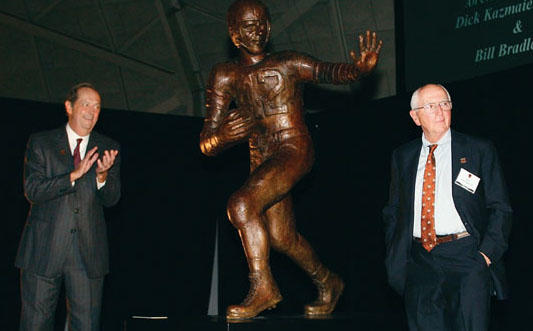As children playing football on a churchyard in Crystal City, Mo., Bill Bradley ’65 and his friends took turns emulating collegiate gridiron stars. Bradley, for a Midwestern boy, had a curious favorite.
“Other kids wanted to be ‘Hopalong’ Cassady of Ohio State,” he recalled. “I wanted to be Dick Kazmaier [’52] of Princeton.”
Kazmaier, the 1951 Heisman Trophy winner, earned national acclaim as a multitalented halfback in the Tigers’ single-wing attack. More than a decade later, Bradley would gain similar fame on the basketball court at Princeton, winning the 1965 Sullivan Award as the country’s best amateur athlete. The two stars shared a common uniform number — 42 — worn, in the words of Director of Athletics Gary Walters ’67, “with uncommon distinction.”
On Oct. 24, the University recognized the accomplishments of Kazmaier and Bradley by retiring No. 42 for all Princeton sports. More than 400 alumni, students, and friends of the athletics program took part in a celebration at Jadwin Gymnasium, where the University raised commemorative banners for both stars and unveiled a life-sized bronze statue of Kazmaier.
Author John McPhee ’53, the Ferris Professor of Journalism, introduced the honorees. McPhee was an undergraduate roommate of Kazmaier, and he wrote a well-known 1965 New Yorker feature about Bradley, “A Sense of Where You Are,” which later became McPhee’s first book.
According to McPhee, 42 remains an important number for the “enduringly superstitious” Kazmaier. It’s on his license plate and in his e-mail address. At Kazmaier Associates in Concord, Mass., the president’s parking spot is No. 42 — even though there are only 36 spaces in the lot. “If you have a chance to be associated with something that’s good, you stay with it,” Kazmaier explained at the ceremony.
A native of Maumee, Ohio, Kazmaier weighed a mere 168 pounds when he debuted as a sophomore, and skeptics wondered if he would last in the Princeton backfield. But his passing, running, and kicking quickly made him a beloved figure. How beloved? When a blow to the head knocked “Kaz” out of his final game — the Tigers’ 22nd consecutive win — The Daily Princetonian called on Nassau Hall to formally protest Dartmouth’s unsportsmanlike play. (The University refrained.) In a video tribute screened at the Oct. 24 event, roommate John McGillicuddy ’52 said, “Every person in our class will say they know Dick.”
In 1961, trainer and equipment manager Eddie Zanfrini prophetically linked Bradley with Kazmaier, handing No. 42 to the 6-foot, 5-inch forward when he joined Princeton’s freshman basketball team. Bradley would sink an unprecedented 57 straight free throws that year — an early indication of his deft shooting touch. In three varsity seasons, he scored 2,503 points and led the Tigers to the 1965 Final Four.
Basketball made Bradley a celebrity — he appeared on the covers of Sports Illustrated and Gentlemen’s Quarterly in his senior year — but the former U.S. senator and one-time presidential candidate values other doors that the game helped to open. At the ceremony, he spoke about a pickup game he played with Carl Belz ’59 *63, a former Princeton basketball captain who earned his Ph.D. in art history. Afterward, Belz invited Bradley to join him at the art museum.
“We stood in front of Manet’s ‘The Fifer’ for about a half hour as he described all of the elements of the picture and how they hung together,” said Bradley, who called it his introduction to the union of scholarship and sport. That union served him well at Princeton and in life after college.












1 Response
Fred Lamparter ’61
9 Years AgoKazmaier one of a kind
I attended Dick Kazmaier ’52’s last football game, noted in the Nov. 19 issue of PAW. As I recall, the rumor was that a badly outclassed Dartmouth team would try to “get” Kazmaier, and they did indeed knock him out eventually with a concussion — to no avail, as far as the final score was concerned.
But Kazmaier returned to the game, concussion notwithstanding, with a few seconds remaining, so that he could walk off the field at the end and receive the accolades of the crowd and his teammates. What I remember most was that he was assigned several big and highly motivated blockers to protect him although, of course, there was never any intention of having him anywhere near the ball. Wisely, Dartmouth left him alone.
By the way, I’ve long wondered why Princeton’s new stadium wasn’t named after Dick Kazmaier — given that there never was and presumably never will be another Tiger football player like him.